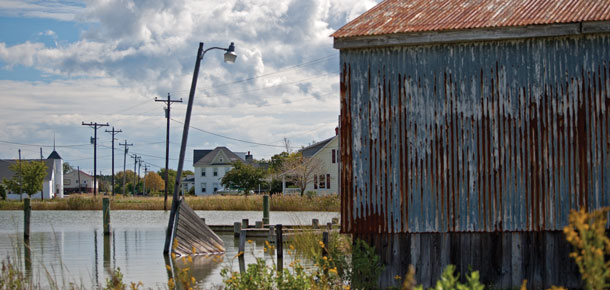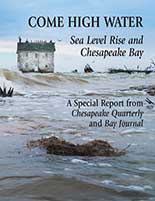Knauss legislative fellowships in Congress help build careers — and they're fun and educational. See our video and fact sheet for details.
The Maryland Sea Grant Bookstore is closed for the winter holidays from Monday, December 15th to Friday, January 5th and will not be taking orders during that time.
Rising Sea Level

The water surrounding Maryland's coasts is slowly but steadily creeping up. Sea level rise, a consequence of global climate change, threatens property, livelihoods, and even lives on Maryland’s coasts. Studies show that sea levels are already rising around Maryland.
Scientists have forecasted a likely increase of 0.8 to 1.6 feet in the Chesapeake Bay by 2050, relative to year 2000 water levels. By the end of this century, that number could exceed 4 feet. Scientists have identified several reasons:
- As oceans around the world grow hotter, they also expand because of the chemistry of salt water.
- Glaciers and ice caps, including the icy regions around Greenland, are melting.
- Since the end of the last ice age, the land around Maryland has been naturally sinking a tiny bit each year.
Maryland Sea Grant Extension specialists partner with local governments, state and federal agencies, non-governmental organizations, academic institutions, and residents to support local efforts for improving coastal climate resilience. We work with coastal communities to help them understand the effects of climate change and sea level rise and prepare for climate-related hazards. We also assist communities with identifying areas of vulnerability and incorporating climate adaptation into their planning efforts. Through workshops, surveys, and town-hall meetings, we share information about coastal resilience work to facilitate partnerships and collaborations among interested parties throughout the region.
Find out more about our efforts to support climate adaptation in coastal communities.
Guidance for Using Maryland's 2018 Sea Level Rise Projections
Rising seas and coastal flooding impact communities, infrastructure, and natural and cultural resources in Maryland. Science-based projections of sea level rise can inform decisions and help reduce the impact of future sea level rise. This guidance document helps state agencies, local governments, NGOs, and other local partners incorporate sea level rise projections into planning and regulatory projects. It provides a step-by-step approach for selecting a sea level rise estimate based on a project’s timeframe, location, and flood-risk tolerance.
Come High Water
 A special report, Come High Water: Sea Level Rise and Chesapeake Bay, offers a comprehensive look at the causes and consequences of increasing flooding along Maryland’s coasts. This package, produced by Maryland Sea Grant's magazine Chesapeake Quarterly in partnership with Bay Journal, examines the scientific understanding and projections of the rate of sea level rise in the Chesapeake region; effects on people and the environment; and adaptations and policy responses that are under way or under consideration. An online interactive page offers videos, photos, and an interactive map showing flooding that is predicted to occur.
A special report, Come High Water: Sea Level Rise and Chesapeake Bay, offers a comprehensive look at the causes and consequences of increasing flooding along Maryland’s coasts. This package, produced by Maryland Sea Grant's magazine Chesapeake Quarterly in partnership with Bay Journal, examines the scientific understanding and projections of the rate of sea level rise in the Chesapeake region; effects on people and the environment; and adaptations and policy responses that are under way or under consideration. An online interactive page offers videos, photos, and an interactive map showing flooding that is predicted to occur.





